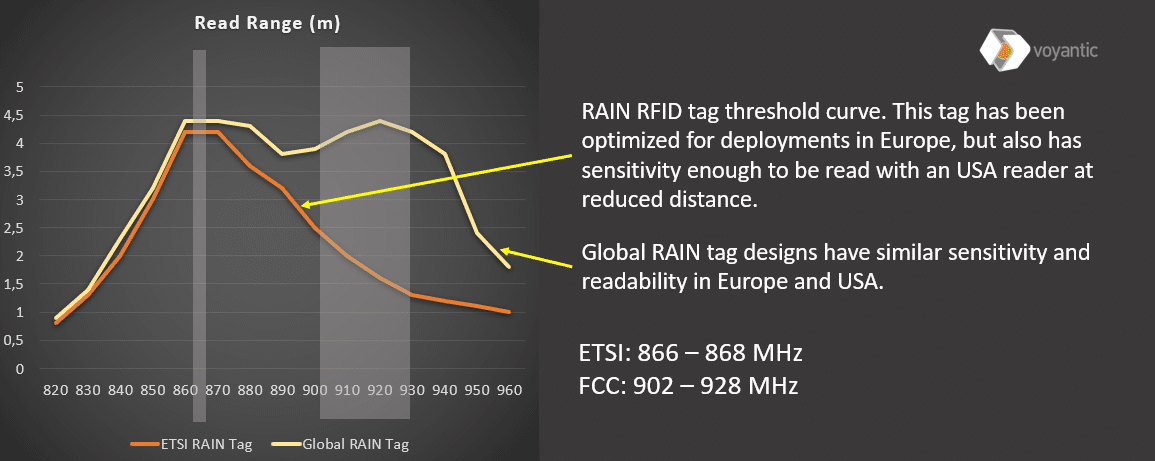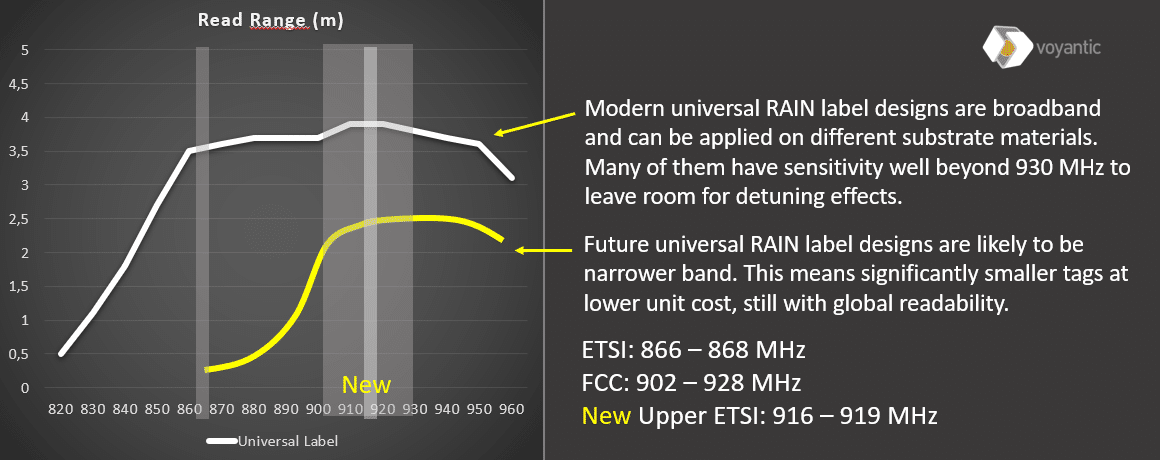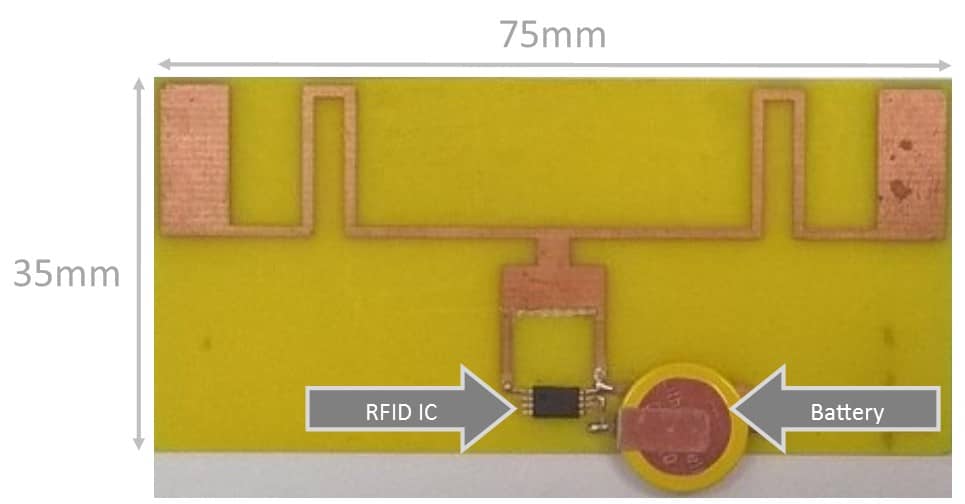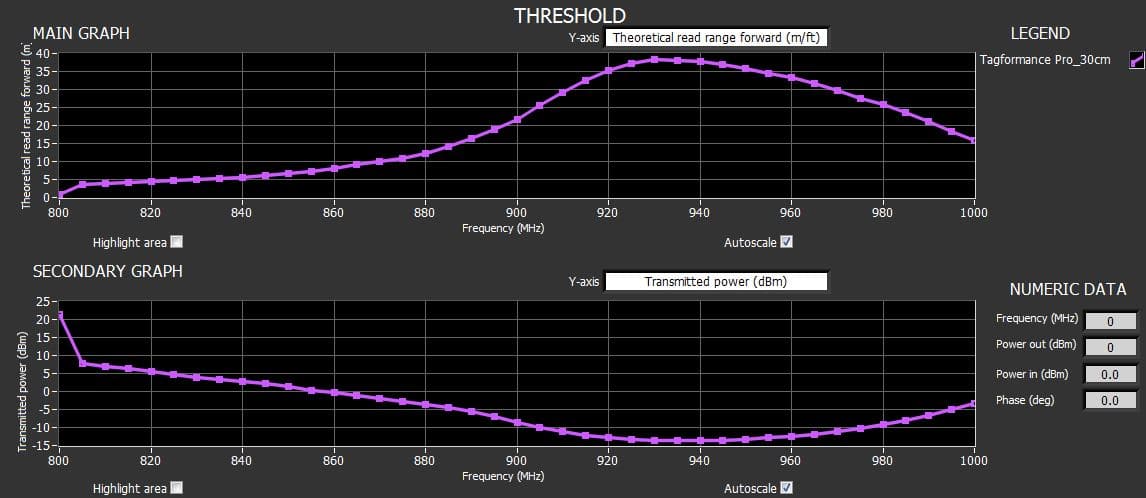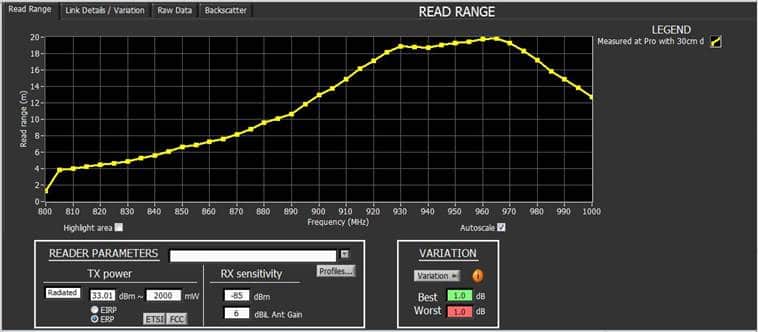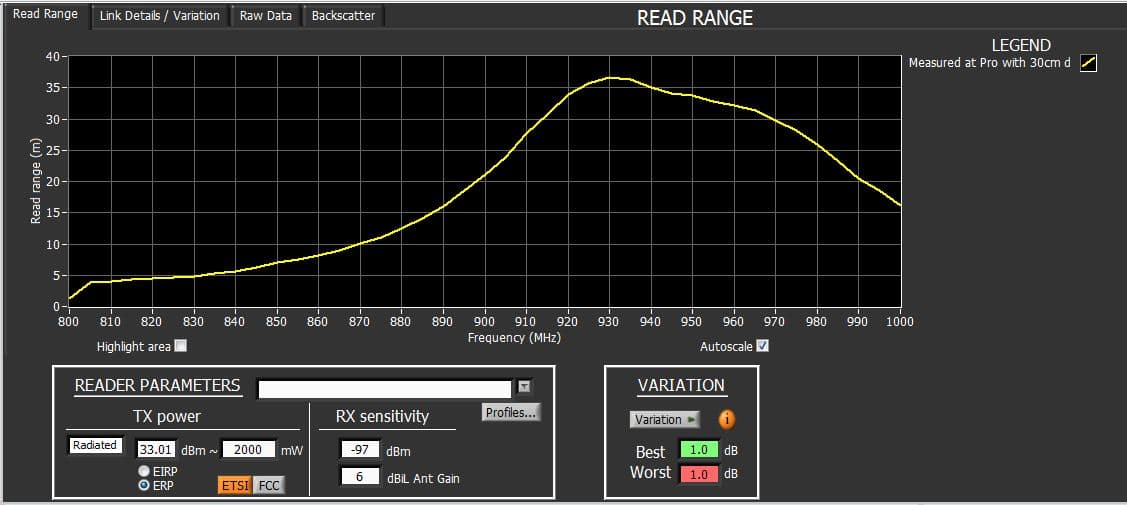Im Januar 2016 hatte ich einen Blog darüber geschrieben, wie RAIN RFID-Unternehmen ihre Interessen vor allem in Europa vertreten sollten. Die Regulierung der Frequenzzuteilung schreitet langsam voran und jetzt, zweieinhalb Jahre später, ist es mir eine große Freude festzustellen, dass die bisherigen Ergebnisse beeindruckend sind. Lassen Sie uns einen Blick darauf werfen, wie die Nutzung des höheren ETSI-Frequenzbandes möglicherweise die Art und Weise der Optimierung des Tagging (Markierung von Objekten mittels RFID RAIN UHF Transpondern) verändert. Sicherlich werden sich diese Änderungen nicht unmittelbar bemerkbar machen. Mein Beitrag hebt zwei Faktoren hervor die derzeit einen unmittelbaren Vorteil dieser neuen Verordnung für den Anwender behindern.
Wie Tags traditionell abgestimmt werden
Im Jahr 2005 wurde das RAIN-Tagging in Europa weitgehend für das Frequenzband 866-868 MHz weitgehend optimiert. Eine solche Kennzeichnung bot in den USA nur eine sehr begrenzte oder nicht vorhandene Lesbarkeit, dies führte schnell zur Entstehung globaler Tag-Designs.
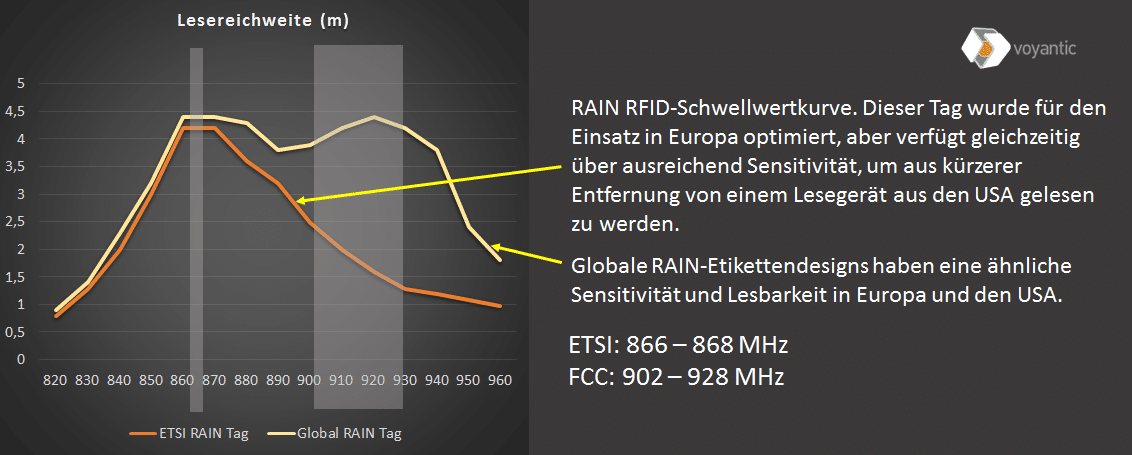
Während die weltweite (globale) Lesbarkeit im Prinzip keine so große technische Herausforderung darstellt, hat dies die Entwickler von Transponder (Tag) Antennen gezwungen, Einbußen bei der Sensitivität der Transponder in Kauf zu nehmen. Bei der Entwicklung von RFID Transpondern für die Montage auf Metall verlangt die globale Lesbarkeit in den Abmessungen deutlich größere Transpondern im Vergleich zu den winzigen Designs für einen stark eingeschränkten Frequenzbereich (ETSI 868 MHz oder FCC 915 MHz). Dies führt nicht nur zu weiteren technischen Herausforderungen sondern stellt auch einen zusätzlichen Preisfaktor dar.
Die Europäische Kommission genehmigt 4W für RFID-Lesegeräte bei 916-919 MHz
Schließlich heißt es im lang erwarteten Durchführungsbeschluss [EU] 2018/1538 der Europäischen Kommission vom 11. Oktober 2018, dass die Mitgliedstaaten bis zum 1. Februar 2019 drei Kanäle innerhalb des Frequenzbandes 916,1 -918,9 MHz für RFID-Lesegeräte öffnen sollten. Damit wird die Norm ETSI EN 302 208 V3.1.0 ergänzt, die ebenfalls ein RFID-Band zwischen 915 und 921 MHz definiert, allerdings mit eingeschränktem Umsetzungsstatus innerhalb der EU und der CEPT-Länder.
Während all dies nach Jahren der technischen Argumentation und Lobbyarbeit nach einem ausgezeichnetem Ergebnis klingt, werden die Hersteller von Lesegeräten vor neue technische Herausforderungen gestellt. Jedoch wie wird sich diese Entscheidung langfristig auf die RFID-Transponder auswirken?
Der optimale Bereich für Tagging auf globaler Ebene
Wie beabsichtigt, wird mit dem oberen ETSI-Band ein global harmonisiertes Frequenzband eingeführt, in dem alle geografischen Regionen verfügbare Kanäle für RFID-Leser haben!
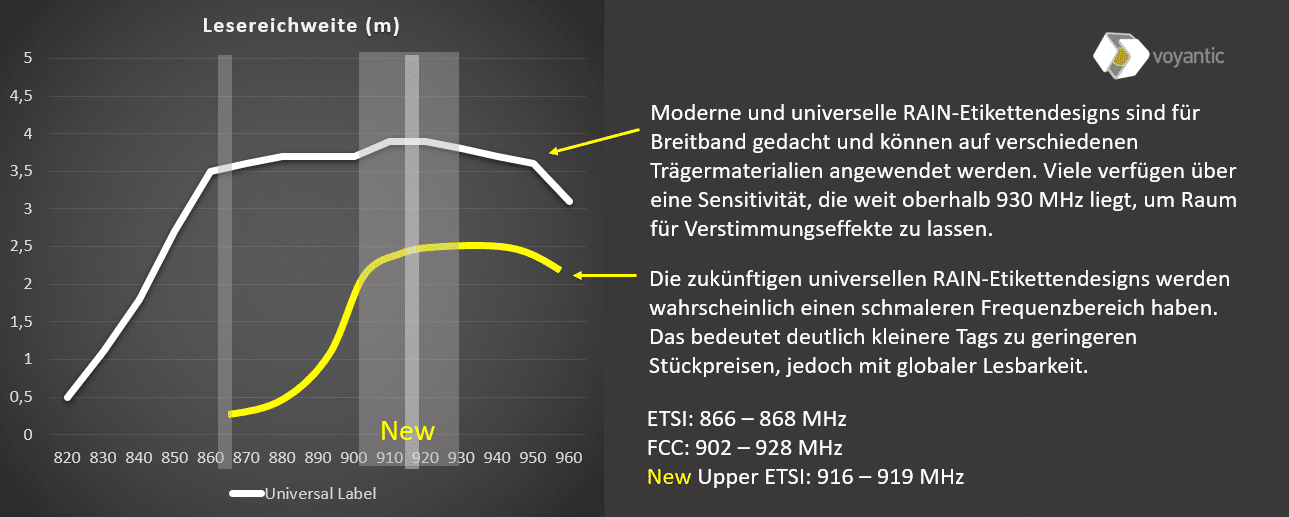
Auch in Europa bietet sich damit die Möglichkeit, das Transponder-Design speziell für den oberen Frequenzbereich zu optimieren. In Anwendungen, in denen die RFID RAIN Lesegeräte (Reader) viel Zeit haben eine Bestandsaufnahme (Inventory) aller Transponder im Lesefeld durchzuführen und durch alle ETSI-Frequenzen zu scannen, sollte eine solcherart eingeschränkte Reaktion von Transpondern, die nur bei den oberen ETSI-Frequenzen wirklich empfindlich sind, kein Problem darstellen. Dies setzt natürlich voraus, dass die ETSI-Lesegeräte in Zukunft sowohl das traditionelle Frequenzband 866-868 MHz als auch das neue obere 916-919 MHz Frequenzband nutzen werden.
Unbekannter Faktor Nr.1: Umsetzungszeitplan in Mitteleuropa
Derzeit nutzt die GSM-R(ailway) das 918-921 MHz Frequenzband in Deutschland, Österreich und Frankreich auf der Grundlage nationalen Rechts gemäß den Frequenz Verordnungen der Internationalen Fernmeldeunion (International Telecommunication Union, kurz: ITU). Leider überlappt sich dieses Frequenzband und das für Europa neue obere ETSI RFID-Band. Die militärische Nutzung desselben Frequenzbereiches in Deutschland ist ein weiteres Fragezeichen und möglicherweise auch ein Hindernis. Die Europäische Kommission hat dieses Problem erkannt und gibt den Mitgliedstaaten die Möglichkeit, die Nutzung von GSM-R und RFID auf der Grundlage von Geographie, spezifischer Installation, Betriebsanforderungen oder ähnlichem zu koordinieren.
Was bedeutet dies nun in der Praxis? Schwer zu sagen. In Deutschland, Österreich oder Frankreich sind noch keine RFID-Umsetzungsrichtlinien veröffentlicht, also ist es von Vorteil die GS1-Übersicht der Regularien für Updates im Auge zu behalten. Die gute Nachricht ist, dass sich das „Future Railway Mobile Communication System“ (FRMCS) nicht mehr mit RFID überschneiden sollte. Die schlechte Nachricht ist, dass noch nicht bekannt ist, wann die Bahnen ein solches System entwickeln oder einsetzen. Das FRMCS-Projekt ist erst seit 2012 im Gange…. Ich persönlich erwarte, dass der Umsetzungsplan in Mitteleuropa bis zur zweiten Jahreshälfte 2019 weiter an Klarheit gewinnt.
Unbekannter Faktor Nr.2: Auswirkung der Leserempfindlichkeit
Der Lesebereich ist oft mehr eine Abschätzung als eine Tatsache, aber die Sensitivität des Lesegeräts ist in der Tat bereits in vielen Anwendungen ein limitierender Faktor. Ein gutes Beispiel ist die Zeitmessung von Marathonläufen. Herr Nikias Klohr von der race result AG hat dieses Thema in seinen exzellenten Präsentationen bei der Konferenz RFID Tomorrow und dem RAIN Face-to-Face-Meeting in Wien 2018 wiederholt angesprochen.
Wir alle haben in den letzten 15 Jahren gesehen, wie sich die erhöhte IC-Empfindlichkeit der Tags zur Entwicklung von Transpondern mit geringeren Abmessungen und nicht zu extrem langen >20 Meter-Lesereichweiten geführt hat. Wenn sich meine Vorhersage zur Optimierung des Tag-Designs für das 902-928 MHz-Band als richtig erweisen sollte, dann werden sich die Abmessungen und Kosten der Transponder weiter verringern.
Bis zum Jahr 2021 könnte die Stärke des rückgestrahlten Signals (Backscatter) von Miniatur-RAIN-Transpondern auf unter -90 dBm bis hinunter zu -100 dBm fallen. Die aktuelle Leserinfrastruktur wird solche geringen Transponder-Signale nicht so einfach interpretieren können. Daher müssen möglicherweise immer noch Transponder in den Abmessungen größer als notwendig verbunden mit höheren Kosten verwendet werden. Aus diesem Grund wird langfristig eine neue Gattung von Lesegeräten und eine Infrastruktur mit verbesserten Lesefähigkeiten benötigt, um die Gesamtkosten der RAIN RFID-Technologie weiter zu senken.
Fazit: Die Arbeit geht weiter
Wie schätzen Sie die Bedeutung der höheren ETSI-Frequenz ein? Haben Sie Einblicke in die regionalen Regulierungsdebatten in Deutschland oder Frankreich? Ich würde mich über einen Austausch zum Thema sehr freuen! Kontaktieren Sie uns dazu gerne.
All blog posts
